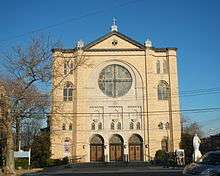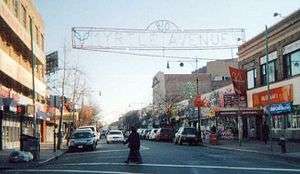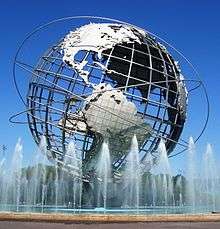Ridgewood, Queens
| Ridgewood | |
|---|---|
| Neighborhood of Queens | |
|
Myrtle Avenue's Business Improvement District runs from Wyckoff Avenue to Fresh Pond Road in Ridgewood where the elevated Bay Ridge Branch of the LIRR crosses over Myrtle Avenue and serves as a border between Ridgewood and the neighboring "lower" portion of Glendale. | |
 Ridgewood  Ridgewood  Ridgewood Location of Ridgewood in Queens, New York | |
| Coordinates: 40°42′00″N 73°54′20″W / 40.70000°N 73.90556°WCoordinates: 40°42′00″N 73°54′20″W / 40.70000°N 73.90556°W | |
| Country | United States |
| State | New York |
| County | Queens |
| Population (2010)[1][2] | |
| • Total | 98,592 |
| • Estimate (2013) | 99,508 |
| Ethnicity[1][2] | |
| • White | 81.7% |
| • Black | 2.1% |
| • Asian | 6.4% |
| • Other | 7.8% |
| Economics[1][2] | |
| • Median income | $42,049 |
| ZIP code | 11385 |
| Area code(s) | 718, 347, 917 |
Ridgewood is a neighborhood in the New York City borough of Queens. It borders the neighborhoods of Maspeth, Middle Village and Glendale, as well as the Brooklyn neighborhoods of Bushwick and East Williamsburg. Historically, the neighborhood straddled the Queens-Brooklyn boundary. The neighborhood is part of Queens Community Board 5.[3]
History
Originally, Ridgewood was part of the Dutch settlement Boswijk (Bushwick) and was later incorporated into the village of Breuckelen (now Brooklyn). A legacy of this past stands today; Onderdonk House, which was erected in 1709.[4] The house is the oldest Dutch Colonial stone house in New York City. Also located at the Onderdonk House site is Arbitration Rock, which was a marker for the disputed boundary between Bushwick and Newtown and essentially Brooklyn and Queens.
Although the area was originally farmed and settled by the Dutch during the 18th and 19th centuries, it was the secondary wave of English settlers who named it Ridgewood after the area's green and hilly terrain. The development of public transportation, from horse-drawn cars in the mid-19th century and later trolleys and elevated trains, helped to spur residential and retail development.[5] Most of the housing stock was built between 1905 to 1915 to house German immigrants who worked in the breweries and knitting factories that straddled the Queens-Brooklyn border.[6][7]
After World War I, the population expanded with an influx of Gottscheers—an ethnic German population from Slovenia who were dislocated in the aftermath of World War I—and Irish, followed soon after by Italians. In April 1934, a large, 9,000-person boycott of Nazi Germany resulted in brawls between Nazi sympathizers and Jewish Communist groups.[8]
In the mid-20th century, Romanians, Serbs, and Puerto Ricans arrived. By the late 20th century, Poles, Dominicans,[9][10][11] and Ecuadorians—including a significant population of Quechua speaking Amerindians from the Imbabura and Cañar provinces of Ecuador—had moved to Ridgewood.[12]
Geography
Topography

The majority of the neighborhood covers a large hill, part of the glacial moraine that created Long Island, which starts at Metropolitan Avenue, rises steeply for about two blocks, then slopes down gently. A good example of just how steep the hill is can be found at Our Lady of the Miraculous Medal Parish. The front entrance of the Church, which is at street level on 60th Place, is almost level with the second floor of the Parish school right next door.
Major streets in Ridgewood include Seneca Avenue, Forest Avenue, Fresh Pond Road, Myrtle Avenue, and Metropolitan Avenue. All are narrow two-lane roads (with parking lanes), and the high volume on these streets can cause traffic tie-ups during rush hour. The intersection of Fresh Pond and Metropolitan is especially notorious for being a bottleneck. The main shopping areas are on Myrtle Avenue and Fresh Pond Road. Other, smaller shopping strips are located on Metropolitan Avenue, Forest Avenue, and Seneca Avenue.
Border with Bushwick, Brooklyn
Today, Ridgewood's land area lies within Queens County. However, its political boundary with Brooklyn causes confusion and debate about where the western boundary of Ridgewood truly lies and whether part of Ridgewood is considered to be actually part of Brooklyn. Ridgewood and its Brooklyn neighbor community, Bushwick, have a grid plan street layout. Because the boundary between Brooklyn and Queens that was historically set in 1769 at the Arbitration Rock lay along a diagonal with this grid plan, the geographic boundary was adapted to the street layout, resulting in a zig-zag pattern. While buildings fronting on streets that are west of Forest Avenue and the Bay Ridge Branch follow the hyphenated house numbering system which is unique to the Borough of Queens, the avenues which run parallel to the county line, bounded by Metropolitan Ave. to the North, Forest Ave. to the East, and the Brooklyn Border to the Southwest do not follow this address numbering system. Streets in this area that run perpendicular to the county line are demarcated by a jump in numbering sequence between the two Boroughs, and by the introduction of the hyphenated address numbering format when crossing from Brooklyn into Queens.
Until the late 1970s, Ridgewood and neighboring Glendale (Queens) were entirely served by the Brooklyn post office in Bushwick. Before ZIP codes were introduced, letters would be addressed to "Ridgewood 27, New York" or "Brooklyn 27, New York" After ZIP codes were instituted either "Ridgewood NY 11227" or "Brooklyn NY 11227." was used. Following events surrounding the New York City blackout of 1977 which marred the public perception of the Bushwick community, the communities of Ridgewood and Glendale expressed a desire to disassociate themselves from Bushwick. In 1979, the two areas were granted a Queens ZIP code, 11385, while Bushwick was designated a separate Brooklyn ZIP code of 11237.[13]
Architecture

Ridgewood is a densely settled neighborhood, with housing stock ranging from six-family buildings near the Brooklyn border to two-family and single-family row houses deeper into Queens. Ridgewood is visually distinguished from Bushwick by the large amount of exposed brick construction; in Brooklyn, vinyl siding is more common. Like neighboring Bushwick, nearly all of the buildings in Ridgewood are classified as combustible.
Most of Ridgewood was developed block-by-block around the turn of the 20th century. Most of the buildings were designed by local architect Louis Berger & Co., which designed more than 5,000 buildings in the area.[14] The neighborhood has been largely untouched by construction since then, leaving many centrally planned blocks of houses and tenements still in the same state as their construction. These blocks include the Mathews Flats (six-family cold water tenements), Ring-Gibson Houses (two- and four-family houses with stores), and Stier Houses (curved two-family rowhouses). Many of these houses are well-kept and retain much of their early 20th century appeal.[15]
Ridgewood is also home to Ridgewood Savings Bank, the largest mutual savings bank in New York State. Their headquarters is located at the intersection of Myrtle and Forest Avenues and was built in 1929. The building architects were Halsey, McCormack and Helmer, Inc. and the general contractors were Stamarith Construction Corporation.[16] The building's exterior is made of limestone and contains an eight-foot granite base. The interior has travertine walls and marble floors.
In Ridgewood 10 national historic districts were listed on the National Register of Historic Places in 1983:[17] 68th Avenue-64th Place Historic District; Central Ridgewood Historic District; Cornelia-Putnam Historic District; Cypress Avenue East Historic District; Cypress Avenue West Historic District; Fresh Pond-Traffic Historic District; Madison-Putnam-60th Place Historic District; Seneca Avenue East Historic District; Stockholm-DeKalb-Hart Historic District; and Summerfield Street Row Historic District. In addition, the New York City Landmarks Preservation Commission has designated three landmark districts in Ridgewood:
- Stockholm Street Historic District, designated 2000[18]
- Ridgewood North Historic District, designated in 2009[19]
- Ridgewood South Historic District, designated 2010[20]
The boundaries of these city-designated districts are indicated in their respective designation reports and may overlap with the federally designated districts listed above. There are also at least two individual city-designated landmarks:
- The Vander Ende-Onderdonk House, built "3rd quarter eighteenth century" and designated in 1995[21]
- The Ridgewood Theater Building, built 1916 and designated in 2010[22]
In addition to the Vander Ende-Onderdonk House, the Evergreens Cemetery, and St. Matthias Roman Catholic Church Complex are listed on the National Register of Historic Places.[17][23]
Transportation
On the New York City Subway, the BMT Myrtle Avenue Line (M train) runs through the heart of Ridgewood, and its connection to the BMT Canarsie Line (L train) at Myrtle-Wyckoff Avenues at the south end of Ridgewood is a transportation hub, with a 60-million-dollar renovation completed in 2007. At the end of the Myrtle Avenue Line is the Fresh Pond Yard, a storage yard for the M train, although the rolling stock themselves are maintained at East New York Yard. Halsey Street (L train) has entrances in both Ridgewood and Bushwick.
The Ridgewood Terminal at that station serves New York City Bus' B13, B26, B52, B54, Q55, Q58 lines. The B20, B38, Q39, Q54 bus lines also serve Ridgewood. In addition, the neighborhood is home to the large Fresh Pond Bus Depot, which services many of the buses that run throughout Brooklyn and Queens.
Education
P.S. 305 is a public school for Pre-K to 3rd grade. P.S. 68, P.S. 71, P.S. 239, P.S. 81 and P.S. 88 are public schools that serve Pre-K to 5th grade. I.S. 77 and I.S. 93 are public middle schools in Ridgewood.
Grover Cleveland High School is the only high school in Ridgewood, and is the zoned public high school to most of Ridgewood. Over the last couple of years there has been serious debate as to whether this high school as well as a number of other schools should be closed down due to low scores and gang violence in and surrounding the school. To this day however, it still remains as the only public high school in the neighborhood.
Sports
From 1886 to 1889, Ridgewood Park was home to the Brooklyn Bridegrooms (later the Brooklyn Dodgers and now the Los Angeles Dodgers) for their Sunday games.[24]
Notable people
Notable current and former residents of Ridgewood include:
- Pedro Beato (born 1986), pitcher who played for the New York Mets.[25]
- James Cagney (1899–1986), actor[26]
- Peter Daempfle (born 1970), author
- Ron Eldard (born 1965), actor[27]
- Jeannie Ortega (born 1986), recording artist, songwriter, actress
- Rosie Perez (born 1964), actress (attended school in Ridgewood)
- Tommy Ramone (1949–2014), musician, original ember of the Ramones.[28]
- Katie Sandwina (1884 - 1952), circus strongwoman and one time "Strongest Woman in the World" opened a restaurant at 70-02 Cypress Hills Street in 1942.[29]
- Dan Schneider (born 1965), poet and critic
- Bob Sheppard (1910–2010), public address announcer for the New York Yankees and New York Giants.[30]
- Gus Van (1886–1968), singer and vaudeville star, part of the team of Van & Schenck
- Reginald VelJohnson (born 1952), actor
- John Ventimiglia (born 1963), actor
Current representatives
- City Council: Elizabeth Crowley (30) & Antonio Reynoso (34)
- State Assembly: Catherine Nolan (37) & Michael G. Miller (38)
- State Senate: Michael Gianaris (12) & Joseph P. Addabbo Jr. (15)
- U.S. Representative: Nydia Velázquez (12) & Yvette Clark (9)
All of Ridgewood's representatives are Democrats.
In popular culture
The Ridgewood Times, established in 1908, and now known as the Times Newsweekly, serves as the community newspaper, and has the largest classifieds section of Queens County community newspapers.
Ridgewood was formerly the site of one of the nation's oldest cinematic theaters, the Ridgewood Theatre. The 1,950 seat William Fox moviehouse was open from 1916 to 2008.[31] Although landmarked, this site will now become an Associated supermarket.
Ridgewood has also served as location shoots for numerous major motion pictures, including The French Connection, A Stranger Among Us, Men in Black 3, The Wanderers, Brighton Beach Memoirs, The Jerky Boys: The Movie, Beat Street and Cop Out. In addition to these movies, scenes for The Sopranos were filmed on Fresh Pond Road in Ridgewood on March 9, 2006, when a hookah bar next to the neighborhood bar, Glenlo's Tavern was detonated, and St.Matthias RC church was transformed into St Petri Norwegian Lutheran Church for Boardwalk Empire on July 12, 2012.
Ridgewood, Queens is referred to in the 2012 song "Stoned and Starving" by indie rock band Parquet Courts.
See also
References
- 1 2 3 Data Access and Dissemination Systems (DADS). "American FactFinder – Community Facts". census.gov.
- 1 2 3 "People in Ridgewood (zip 11385), New York". bestplaces.net.
- ↑ Queens Community Boards, New York City. Accessed September 3, 2007.
- ↑ "The Vander Ende-Onderdonk House". Greater Ridgewood Historical Society. Archived from the original on November 4, 2010. Retrieved 15 October 2010.
- ↑ New York Times: "A Neat Enclave Enriched by Waves of Immigrants" April 9, 2006
- ↑ WPA Guide to New York City: The Federal Writers' Project Guide to 1930s New York. 1939.
- ↑ New York Times: "The Germans Came; Now They Are Us; An Ethnic Queens Neighborhood Is Melting Away Into America" October 25, 2003
- ↑ "Fists Fly at Rally of 9,000 Nazis Here: Hitler Adherents Clash with Rival Groups in 18 Brawls at Queens Meeting". New York Times. 9 April 1934.
- ↑ New York Times: "Living in Ridgewood, Queens December 30, 2011
- ↑ "Growing up in Ridgewood, New York in the 1960’s–1970’s – Part 1" by Gerard Demarigny March 23, 2010
- ↑ Polish Migrations: From Brooklyn to Queens, and back to Europe by Shuka Kalantari and Daniel Macht; retrieved January 1, 2012
- ↑ All Peoples Initiative: Quichua in New York and New Jersey August 2007
- ↑ Lee, Jennifer 8. (November 2, 2007). "Is Ridgewood the New East Bushwick?". The New York Times. Retrieved August 21, 2009.
- ↑ "Ridgewood MRA" (PDF).
- ↑ Wilkinson, Christina. Forgotten New York: Ridgewood
- ↑ "NOTABLES ATTEND FORMAL OPENING OF BANK'S HOME" (PDF). THE DAILY STAR. March 17, 1930. Retrieved 5 February 2013.
- 1 2 National Park Service (2009-03-13). "National Register Information System". National Register of Historic Places. National Park Service.
- ↑ "Stockholm Street Historic District" (PDF). New York City Landmarks Preservation Commission. Retrieved 10 October 2013.
- ↑ "Ridgewood North Historic District Designation Report" (PDF). New York City Landmarks Preservation Commission. Retrieved 10 October 2013.
- ↑ "Ridgewood South Historic District Designation Report" (PDF). New York City Landmarks Preservation Commission. Retrieved 10 October 2013.
- ↑ "Adrian and Ann Wyckoff Onderdonk House Designation Report" (PDF). New York City Landmarks Preservation Commission. Retrieved 10 October 2013.
- ↑ "Ridgewood Theater Building Designation Report" (PDF). New York City Landmarks Preservation Commission. Retrieved 10 October 2013.
- ↑ "National Register of Historic Places Listings". Weekly List of Actions Taken on Properties: 9/04/12 through 9/07/12. National Park Service. 2012-09-14.
- ↑ Ballparks: 1862 - Present, Brooklyn Dodgers. Accessed August 21, 2007.
- ↑ Castillo, Jorge. "From a Long Toss From Shea to a Mets Closer", The New York Times, July 17, 2011. Accessed June 15, 2016. "Beato and his family settled in Woodside, Queens, a long toss from Shea Stadium, where his adopted hometown team, the Mets, played. His family would later move to Ridgewood, on the Queens-Brooklyn border, and he attended Xaverian High School in Brooklyn."
- ↑ Garcia, Krista (August 2, 2002). "Close-Up On: Ridgewood, Queens". Village Voice. Retrieved March 8, 2008.
- ↑ Yarrow, Andrew L. (December 29, 1989). "New Faces: Annabella Sciorra and Ron Eldard; The Actors Who Gave Life To the Couple in 'True Love'". The New York Times. Retrieved April 10, 2008.
I've always been disturbed at how Italian-Americans are usually portrayed in movies, but Nancy and Rich made it clear they weren't looking for stereotypes,' Mr. Eldard said. 'Half my family is Sicilian, and where I lived in Queens, in Ridgewood, is very Italian.
- ↑ Sisario, Ben. "Tommy Ramone Dies at 65; He Gave Punk Rock Its Pulse", The New York Times, July 12, 2014. Accessed June 15, 2016. "Tom Erdelyi, better known as Tommy Ramone, the founding drummer and last surviving original member of the Ramones, the New York City band whose dizzying, short blasts of melody codified the sound of punk rock, died on Friday at his home in Ridgewood, Queens."
- ↑ "TIMES NEWSWEEKLY/OUR NEIGHBORHOOD THE WAY IT WAS". www.timesnewsweekly.com. Retrieved 2016-07-26.
- ↑ Coffey, Wayne. "For nearly 60 years Bob Sheppard has set tone of Yankee Stadium", New York Daily News, September 20, 2008. Accessed June 15, 2016. "The son of a New York City building inspector, Sheppard was born in Ridgewood, Queens before the family moved to Richmond Hill."
- ↑ http://cinematreasures.org/theater/4021/
Further reading
- New York Times story on 5 Families Move From East Village to Ridgewood
- Page about the Ridgewood Theatre, and the debate over borough identity
- History of Ridgewood, NY
External links
| Wikimedia Commons has media related to Ridgewood, Queens. |

